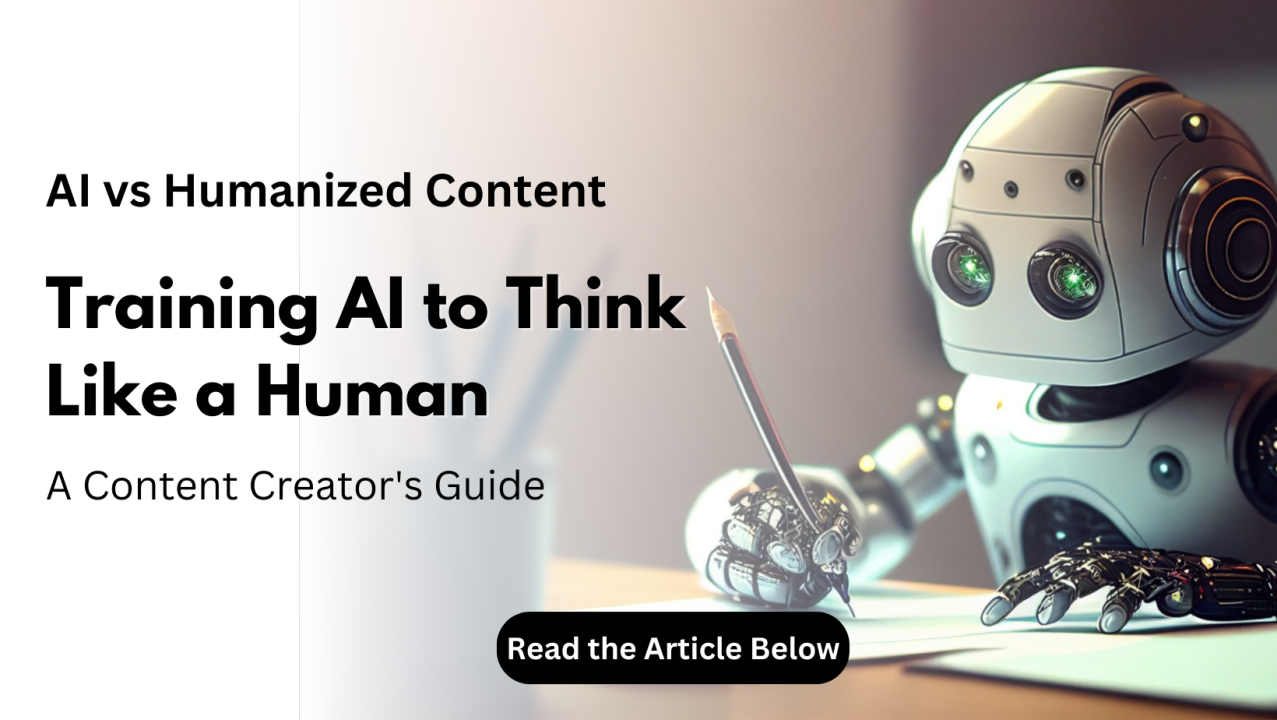AI vs Humanized Content
The distinction between human-generated and AI-generated content is important, especially in terms of how audiences perceive it, its tone, and the depth of understanding it conveys. Here are some key differences and considerations between the two:
1. Tone and Authenticity
- Humanized Content: Human-generated content tends to have a more natural tone and can convey subtle emotions, humour, and empathy. It reflects the writer’s personality, experiences, and unique voice, which can make it feel more relatable and genuine to readers.
- AI Content: AI-generated content can mimic a natural tone but may sometimes feel formulaic or lack a deeper sense of emotion or context. While AI can be programmed to match a specific tone, it may miss nuances or cultural references that come naturally to a human writer.
2. Contextual Understanding
- Humanized Content: Humans better understand context, cultural nuances, and the bigger picture. They can make connections between ideas and bring in personal experiences that enrich the content.
- AI Content: AI can handle large datasets and generate content based on the patterns it identifies, but it may lack a deeper understanding of certain contexts. AI might not fully grasp complex topics that require a nuanced interpretation or draw from real-world experiences.
3. Creativity and Originality
- Humanized Content: Humans bring unique creative perspectives and can experiment with storytelling, analogies, and metaphors. Their creativity is influenced by diverse experiences, allowing for innovative and fresh ideas.
- AI Content: AI can produce creative content within the patterns it has learned, but its originality is limited by the data it has been trained on. It might struggle to produce truly novel concepts or approaches, especially in fields that require lateral thinking.
4. Efficiency and Scale
- Humanized Content: Producing content manually can take time, as it involves research, drafting, and revisions. However, it can be tailored specifically to a target audience or situation, ensuring a precise match to needs.
- AI Content: AI can generate large volumes of content quickly, making it ideal for repetitive or time-sensitive tasks like product descriptions, summaries, or news updates. This can be a huge time-saver for businesses that need scalable solutions.
5. SEO and Data-Driven Content
- Humanized Content: Human writers can craft content that is both engaging and optimized for search engines by integrating strategic keywords naturally. They can also adapt their writing style based on feedback and evolving SEO trends.
- AI Content: AI excels at analyzing search trends and generating content with keyword optimization. It can automate much of the SEO-driven content creation, but the output may sometimes prioritize keywords over readability.
6. Engagement and User Trust
- Humanized Content: Readers may feel a stronger connection to content when they know it comes from a human, especially for topics that require a personal touch like mental health, storytelling, or opinion pieces.
- AI Content: AI content can be engaging, but users may perceive it as less trustworthy in certain contexts, especially if they value an author’s expertise or personal experience. Transparency about using AI is crucial for maintaining trust.
Conclusion
Both humanized and AI-generated content have their strengths and ideal use cases. Human content is best suited for scenarios where nuance, empathy, and creativity are needed, while AI content excels in efficiency, scalability, and data-driven tasks. A balanced approach, where AI assists in research or drafting while humans refine and personalize the content, often works best.

Identifying Humanized vs. AI-Generated Content: Key Differences
Identifying whether content is generated by a human or AI can be challenging, especially as AI models have become more sophisticated. However, several characteristics and clues can help you differentiate between humanized content and AI-generated content:
1. Tone and Flow
- AI-Generated Content: AI often produces content that is grammatically correct but can sound formal or slightly rigid. It might lack the natural variation, humour, or casual conversational tone that humans tend to use. AI can struggle with understanding irony, sarcasm, or subtle humour.
- Humanized Content: Humans are more likely to use a variety of sentence structures, slang, regional phrases, and expressions. They can adapt their tone according to the topic, adding a more personal touch or emotional angle that resonates with readers.
2. Repetitiveness
- AI-Generated Content: AI may repeat certain phrases or ideas more often, especially if it is using common templates. It might also use slightly off or redundant phrasing when generating longer pieces of content, like awkwardly using synonyms or restating concepts with little variation.
- Humanized Content: While humans can also be repetitive, they are more likely to bring in unique perspectives, varied examples, or switch between different points of view when explaining a concept. They tend to break up the flow with anecdotes or asides.
3. Depth of Understanding
- AI-Generated Content: AI can generate content that sounds knowledgeable but may lack a deep understanding of the topic. It might present information in a factual, surface-level manner without exploring more nuanced arguments, context, or implications.
- Humanized Content: Humans can often dive deeper into a subject, drawing on personal experiences, providing insights, or discussing the practical applications and implications of information. They may add emotional elements, like opinions or reflections, that show a deeper engagement with the topic.
4. Errors and Imperfections
- AI-Generated Content: AI tends to be free from common typos or basic grammar mistakes since it follows grammatical rules strictly. However, it may make errors in understanding context, like using a word correctly grammatically but not in the right context or failing to understand cultural nuances.
- Humanized Content: Humans are more likely to make small typos, occasional grammatical mistakes, or even misspellings. These imperfections can sometimes be a sign that a person wrote the content. Humans might also use informal grammar or stylistic choices that deviate from strict grammar rules.
5. Complexity and Structure
- AI-Generated Content: AI often generates content with a structured, almost robotic flow—introduction, points, conclusion—because it’s trained on structured data. It might lack smooth transitions between ideas and may follow a somewhat predictable pattern.
- Humanized Content: Human writers might use a more varied structure, including abrupt shifts in tone or style that reflect their thought process. They might go off on a tangent or explore side topics that enrich the content and give it a more dynamic, less linear feel.
6. Cultural and Local References
- AI-Generated Content: AI may miss out on subtle cultural references, inside jokes, or local colloquialisms that a human would naturally include. For example, it might struggle to make references to recent events, regional humor, or niche cultural phenomena unless specifically trained on that data.
- Humanized Content: Humans are better at integrating culturally relevant references, jokes, or metaphors that resonate with specific audiences. These references often make the content feel more tailored and specific.
7. Emotion and Opinion
- AI-Generated Content: AI is less likely to express strong personal opinions, emotions, or biases, as it typically aims for a neutral tone unless otherwise specified. Even if it generates opinions, they might sound generic or overly balanced.
- Humanized Content: Humans tend to write with more passion, express strong viewpoints, or convey emotions like excitement, frustration, or empathy. This makes the content feel more personal and relatable.
8. Tools for Detection
- There are online tools that can analyze content to determine whether it might have been AI-generated. These tools often look at statistical features like sentence length, complexity, and common patterns. Examples include tools like OpenAI’s own detection tool, GPTZero, or Originality.ai.
- These tools aren’t perfect and can sometimes misidentify content, especially as AI gets better at mimicking human writing styles. But they can provide an additional layer of insight.
9. Verification and Source Checking
- If you’re unsure whether a piece of content is AI-generated, checking the background of the source or author might help. For instance, if a website is known to use AI-generated summaries or articles, that could be a clue. Some sites or publications may even disclose the use of AI in content creation.
Summary
While AI-generated content is becoming more sophisticated, it often lacks the nuances, creativity, and imperfections that characterize human writing. Looking for signs like repetitive patterns, lack of depth, and rigidity in style can help distinguish between the two. However, as AI continues to evolve, the line between human and AI-generated content is likely to become more blurred, making detection more challenging.
Examples of Humanized and AI-Generated Content: A Comparative Analysis

Topic: “The Benefits of Remote Work”
Example 1: Humanized Content
Remote work has completely changed my life—it’s like gaining back precious hours of my day. Instead of dealing with the exhausting morning commute, I can now start my day with a cup of coffee on the balcony, soaking in the sunrise. It’s not just about comfort, though. Being able to create my own workspace, with my favorite plants and a playlist of nostalgic 90s hits, makes a huge difference in productivity. Plus, I’ve noticed a boost in my mental health—no more squeezing into packed subway cars or dealing with office small talk when I just want to focus.
Example 2: AI-Generated Content
Remote work offers several benefits, including increased flexibility, better work-life balance, and improved productivity. Employees no longer need to commute, which saves time and reduces stress. This time can be used for exercise, family activities, or personal hobbies, contributing to a more balanced lifestyle.
Analysis of the Differences
@ Tone and Emotion:
- The humanized example is more personal and reflective, using first-person anecdotes and descriptions like “gaining back precious hours of my day” and “soaking in the sunrise.” It expresses feelings about remote work, such as joy and relief, and includes personal struggles with balancing work and home life.
- The AI-generated example is more factual and neutral, focusing on listing the benefits and challenges of remote work. It uses terms like “improved productivity” and “job satisfaction” without delving into emotional experiences.
@ Creativity and Style:
- The humanized example includes unique phrases and creative descriptions like “a playlist of nostalgic 90s hits” and “office small talk when I just want to focus.” It has a storytelling element that makes it engaging.
- The AI-generated example follows a more structured, systematic approach, providing information clearly and directly. The creativity is less evident, and it relies on general concepts.
@ Depth and Context:
- The humanized example goes into the emotional aspects of remote work, such as mental health improvements and the feeling of freedom. It gives a well-rounded picture of both the positives and the challenges in a more personal way. The AI-generated example is informative but lacks deeper emotional context. It mentions challenges and solutions without elaborating on the human experience behind them.
- The AI-generated example is informative but lacks a deeper emotional context. It mentions challenges and solutions without elaborating on the human experience behind them.
@ Language and Variations:
- The humanized example uses more varied language and less predictable sentence structures, which makes it feel more natural.
- The AI-generated example has a more standardized style, which can sound a bit formulaic for conveying clear information but not as engaging or personable.

Can We Train AI for Humanized Content? Strategies and Techniques
Yes, it is possible to train an AI tool to create content that feels more humanized. The key is to adjust the training data and process so that the AI can better mimic the nuances, style, and emotional tone often found in human writing. Here’s how you can go about it:
1. Curate a High-Quality Dataset
- Select Diverse and Human-Centric Content: The training dataset should include a variety of content that captures human expression, tone, and storytelling. This can include blog posts, opinion pieces, personal essays, creative writing, and even transcripts of natural conversations. The more diverse the content, the better the AI can learn to adapt its style to different contexts.
- Include Different Tones and Emotions: Curate content that exhibits different emotional tones, like humor, empathy, excitement, or seriousness. This helps the AI learn how to express different moods, making the output more dynamic and engaging.
- Filter for Quality: Focus on content that is well-written and resonates with readers. By prioritizing engaging, creative, and thoughtful pieces, you train the AI to learn from the best examples of human-like writing.
2. Fine-Tune on Specific Styles and Voices
- Use Transfer Learning: Fine-tuning a pre-trained language model (such as GPT) on a custom dataset can make the AI more adept at generating humanized content. This involves taking an existing, general AI model and training it further using your curated dataset.
- Custom Style Tuning: If you have a particular style in mind (e.g., informal blogs, storytelling, or emotional reflection), create a dataset specifically in that style and fine-tune the model on this data. This allows the AI to generate content that better matches a desired tone or voice.
3. Incorporate Feedback Loops
- Human-in-the-Loop Training: Involve human editors who review and adjust AI-generated content, highlighting where the AI misses the mark in terms of tone or style. Feed these adjustments back into the training process so the AI learns from the corrections.
- Reinforcement Learning with Human Feedback (RLHF): This method involves using human feedback to improve the AI’s performance iteratively. A human reviews the AI’s output and ranks different versions of generated content based on how human-like they feel. The AI then learns to prioritize patterns that are rated higher by humans.
4. Teach the AI to Understand Context and Emotions
- Annotate Emotions: In the training data, include labels or markers that identify different emotions or tones (e.g., [happy], [serious], [reflective]). This helps the AI understand how to adjust its output based on the emotional context of a piece of content.
- Contextual Prompts: Train the AI with examples where it must understand the context of a prompt to generate an appropriate response. For instance, provide examples where a prompt might suggest a more casual, humorous response or a more formal, serious one.
5. Use Prompt Engineering for Style Control
- Guide the AI with Specific Prompts: After training, you can control the output style through prompt engineering, giving the AI more explicit instructions. For example:“Write a friendly and informal blog post about working from home.”“Tell a story about the benefits of remote work in a conversational tone.”
- Instruct on Tone and Voice: By providing more detailed prompts that specify the desired style or approach, you can influence the AI to generate content that aligns better with a human-like tone.
6. Simulate Common Human Traits
- Include Realistic Mistakes (Optional): If you want to simulate a more human-like feel, you could train the model to sometimes include minor, natural mistakes like typos, colloquial expressions, or casual language. However, this should be done carefully, as it can be a double-edged sword—readers might appreciate the authenticity, but frequent errors can also reduce the perceived professionalism.
- Train with Examples of Self-Reflection: Include content that has elements of self-reflection, internal monologue, or personal anecdotes. This helps the AI learn to write content that is more introspective and relatable, like how a human might share thoughts in a personal blog.
7. Adjust Temperature and Sampling Parameters
- Modify Temperature Settings: Temperature is a parameter that controls randomness in AI-generated content. A higher temperature setting leads to more creative and varied output, which can help make content feel less formulaic. Adjusting this can make the AI’s responses feel more dynamic and less predictable.
- Use Top-k or Top-p Sampling: These methods help the AI to pick from a more diverse set of possible responses, making the content less robotic. It ensures that the AI doesn’t always choose the most likely word or phrase, which can help it emulate the varied word choices that human writers naturally use.
8. Leverage AI Writing Assistants with Human Input
- Hybrid Writing Models: Use AI as a co-writing tool where it generates content that a human editor refines. This combination can produce high-quality, human-like content while leveraging the AI’s efficiency. The AI can suggest drafts, outlines, or snippets, which are then polished by a human for tone and personality.
- Train on Dialogue for Better Conversational Style: Fine-tuning on conversations, such as chat logs or interview transcripts, can help the AI become better at mimicking natural conversational style and casual interactions.
Summary of the Approach
- Curate high-quality, human-centric training data.
- Fine-tune the model on specific styles and voices.
- Use human feedback loops and reinforcement learning.
- Train the AI on understanding emotional context.
- Use prompt engineering to guide style.
- Adjust parameters for randomness and creativity.
By following these steps, you can train an AI to generate content that is closer to human writing in tone, style, and emotion. It requires careful dataset curation and ongoing feedback, but it can result in a model that produces more natural and engaging content.


